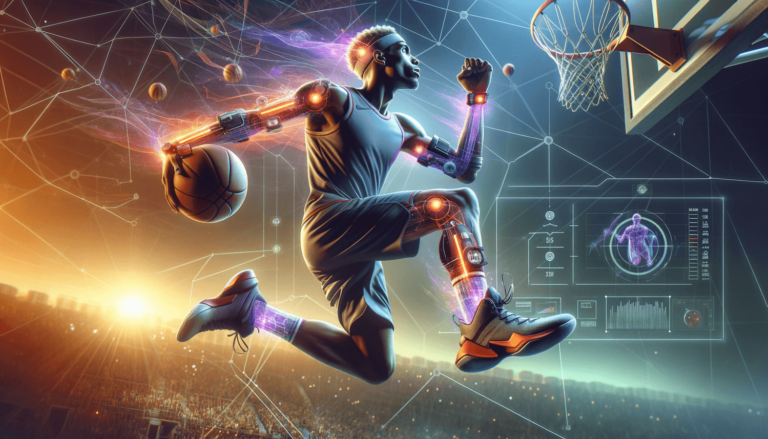
Impact of Wearable Technology on Basketball Performance Analysis
Written by: Basketball Universe
Last updated:

From shooting hoops to alley-oops, basketball has continually evolved and adapted, breaking boundaries and bringing innovation to the court. In today’s world of rapid technological advancements, it’s no surprise that wearable technology has found its place within the realm of basketball performance analysis. Strap in and get ready to dribble your way through our discussion on how these powerful, cutting-edge devices are revolutionizing the game, providing valuable insights, and enhancing players’ skills. Combining the best of sports and tech, we’ll delve into the impact of wearable technology on basketball in this fun yet professionally insightful blog post!
Impact of Wearable Technology on Basketball Performance Analysis
Wearable technology has had a significant impact on basketball performance analysis through real-time monitoring, data collection, and performance optimization. These devices, including smart apparel, wristbands, and shoes, enable collection of vital biometric and performance data such as heart rate, speed, and movement patterns. The gathered information helps players, coaches, and trainers to make informed decisions on training regimens and game strategies, enabling a more personalized approach to improve individual and team performance. As a result, the use of wearable technology in basketball has enhanced skill development, injury prevention, and overall competitiveness within the sport.
From Court to Tech: The Evolution of Basketball Performance Analysis
Long gone are the days when a simple stop-clock was the pinnacle of basketball performance analysis. The landscape of basketball technology has advanced at a steady pace, and it’s essential to acknowledge how far we’ve come. While basketball history is replete with groundbreaking ideas and strategies, the arrival of wearable tech has proved to be a game-changer. In this section, we’ll discuss the evolutionary journey of basketball performance analysis and how wearable technology has taken center court.
Early Days of Basketball Analysis
In the early days, coaches and trainers relied heavily on in-person observation and conventional coaching methods to understand and refine their players’ skills. Additionally, they depended on manually recorded statistics such as game scores, shooting percentages, and rebound counts to evaluate performance. While these metrics served a purpose, they lacked the precision and depth needed to make significant performance improvements.
From Video to Advanced Analytics
The introduction of video recording technology marked a significant shift in basketball performance analysis. Coaches could now review game footage and evaluate players’ effectiveness on the court more carefully. As technology continued to evolve, advanced basketball analytics entered the scene, allowing coaches to focus on metrics such as player efficiency ratings, offensive and defensive ratings, and impact statistics.
The Wearable Tech Revolution
Fast forward to today, and wearable technology has taken basketball performance analysis to new heights. Devices equipped with motion sensors, GPS, and heart rate monitors provide real-time data on speed, movement, and player fatigue to enable better decision-making and performance optimization for athletes and coaches alike. Let’s dive deeper into the impact of wearable technology in the following sections.
Smart Apparel: Bringing the Future to Basketball Fashion
When you think about wearables in sports, intricate gadgets might be the first thing that comes to mind. However, smart apparel has also made a significant impact on basketball performance analysis, creating an environment where your gear truly works to your advantage. Let’s explore the fascinating world of basketball smart apparel and its impact on performance analysis.
Smart Shirts and Vests
Smart shirts and vests have weaved sophisticated technology into their fabric, offering personalized performance tracking for athletes. They typically include built-in heart rate monitors, accelerometers, and gyroscopes to monitor biometric data like heart rate, acceleration, and balance. This data provides insights into a player’s endurance, agility, and overall performance, enabling coaches and trainers to make informed decisions about training regimens and game strategies.
Intelligent Socks
The latest innovation making strides in the realm of wearable technology for basketball is intelligent socks. These specially designed socks are engineered to monitor foot motion and analyze key factors such as balance, foot pressure, and plantar flexion. By better understanding these metrics, teams can improve players’ footwork, cater to individual strength, and further optimize performance during games and practices.
Wrist-based Wearables: The Power of High-performance Metrics at Your Fingertips
Wrist-based wearables have dominated the wearable technology market, and their impact on basketball performance analysis is undeniable. From simple fitness trackers to advanced sports analytics devices, these wearable gadgets have become indispensable tools for athletes and coaches. Let’s explore how wrist-based wearables are transforming basketball performance analysis.
Fitness Trackers
Fitness trackers are lightweight, unobtrusive devices worn around the wrist that track physical activity, including steps taken, distance traveled, and calories burned. While primarily used for general health and well-being, these devices can provide valuable insights into a basketball player’s daily activity level and fitness trends, helping them maintain peak performance on and off the court.
Advanced Sports Analytics Devices
Specifically designed for high-performance athletes, advanced sports analytics wearables combine various motion sensors with powerful analytics software to help basketball players fine-tune their skills. These devices provide insightful in-depth metrics, including jump height, shot accuracy, and player hustle, to help enhance on-court performance.
Smart Basketball Shoes: Groundbreaking Innovation for an Unmatched Performance
Your basketball shoes are more than just a fashion statement; they can be the key to unlocking your full potential on the court. With the integration of wearable technology into basketball footwear, smart basketball shoes are redefining the future of basketball performance analysis. Let’s examine the impact this groundbreaking innovation has on the game.
Performance Tracking and Analysis
Smart basketball shoes often feature built-in sensors that track movement, speed, and jump height, providing players and coaches with real-time performance data. This information is crucial for optimizing on-court performance, making informed strategic decisions, and monitoring player development over time.
Injury Prevention and Recovery
With built-in accelerometers and pressure sensors in their soles, smart basketball shoes monitor the intensity and impact of a player’s movements. By doing so, they provide valuable insights into potential injury risks, such as incorrect landing techniques, excessive stress on joints, and unbalanced foot pressure. Armed with this data, coaches and trainers can develop tailored exercises and training programs to address these vulnerabilities, making injury prevention and recovery a more personalized process.
Leveraging Data for Improved Decision-making
The immense amount of data generated from various wearable devices can be overwhelming. However, with the right tools and strategies, this information can be transformed into actionable insights that can propel a team towards its performance goals. In this section, we’ll discuss how teams are leveraging wearable technology data for strategic decision-making.
Data-driven Training Programs
A crucial aspect of utilizing wearable technology data is to develop data-driven training programs tailored to individual players’ needs. This approach allows coaches, trainers, and athletes to focus on specific areas of improvement, ensuring optimal results and a more efficient use of training time.
Monitoring Workload and Risks
Wearable technology provides the critical advantage of monitoring players’ workload, helping coaches and trainers strike the right balance between pushing their athletes to excel and ensuring their well-being. By analyzing data from wearable devices, teams can identify potential physical risks, such as fatigue, overtraining, or injuries, and adjust their training programs accordingly.
Real-time Performance Monitoring during Games
Wearable technology allows coaches to monitor player performance in real-time during games, helping them make informed substitutions, manage fatigue, and adjust their game strategies on the fly. By responding to real-time performance data, coaches can give their teams a competitive edge over opponents and maximize the potential of each player.
With wearable technology’s ever-evolving presence in basketball, the impact on performance analysis will only continue to grow. By embracing this cutting-edge tech, today’s athletes and coaches can make data-driven decisions, optimize performance, and ultimately advance the game’s basketball history by adding to its legacy of innovation and excellence.
Integrating Wearable Technology Data: Strategies for Success
Now that we’ve explored the various wearable devices used in basketball, it’s essential to highlight the effective integration of this technology to best utilize its benefits. In this section, we’ll discuss different strategies for successfully incorporating wearable technology data into the world of basketball.
Choose the Right Wearable Technology
Given the wide range of wearable technology options available for basketball performance analysis, it’s crucial to choose the right device for your specific goals. Evaluate the features and metrics provided by each wearable and consider the individual needs of your team and players. Selecting the most relevant technology will ensure you receive actionable data that supports your performance objectives.
Develop a Comprehensive Performance Analysis Plan
Integrating wearable technology requires a well-thought-out performance analysis plan. Identify key performance indicators that are relevant to your team, such as shooting accuracy, speed, agility, and more. Understanding which metrics are most important and useful for your players helps prioritize data collection and analysis, ultimately leading to better application of the data and enhanced performance.
Provide Continuous Feedback and Communication
Communication is key when it comes to successfully implementing wearable technology data for performance improvement. Clearly explain the purpose of the technology to your team and make sure they understand the benefits. Share analysis results and feedback with players regularly, involving them in the decision-making process. This promotes trust, engagement, and motivation, ensuring everyone reaps the benefits of wearable technology.
Make Data Easy to Understand and Apply
Wearable technology can provide an overwhelming amount of data, which may create confusion or disinterest among players. To prevent this, present data in an easily digestible format and focus on the most relevant insights. Simplify charts, graphs, or reports so that everyone on the team can understand and apply the insights, driving performance improvement.
Monitor Success and Adapt Metrics Over Time
One of the magic ingredients to successfully integrating wearable technology data is constant monitoring and analysis. Teams and players should track their progress using wearable devices and adjust their performance goals and metrics as needed. This ensures a dynamic, adaptive process that evolves with the team and players, facilitating ongoing growth and development.
Legal and Ethical Considerations of Wearable Technology
With the rapid adoption of wearable technology in basketball, it’s crucial to address the legal and ethical concerns surrounding its use. In this section, we’ll discuss some of the most pressing considerations that need to be addressed to responsibly harness the power of this groundbreaking technology.
Data Privacy
Wearable technology collects a wealth of personal and potentially sensitive data about players. As such, it’s essential to have a robust data privacy system in place. This should include adhering to relevant data protection laws, obtaining the necessary permissions from players, and securely storing and managing collected data. Ensuring data privacy helps build trust among players and prevents the unauthorized use or sharing of personal information.
Equitable Use
With the potential for wearable technology to significantly impact player performance, there’s a risk of using this technology to gain an unfair competitive advantage. Teams should follow guidelines and regulations set forth by governing bodies that ensure fair and equitable use of wearable devices in competitions. This protects the spirit and integrity of the sport and promotes a level playing field for all participants.
Player Autonomy
Players should not feel coerced into using wearable technology or sharing their private data with others. As a coach, it’s important to respect and acknowledge the autonomy of your athletes. Discuss the benefits and potential risks involved with wearable technology with your team members, and ensure they make voluntary, informed decisions about using these devices to enhance their performance.
By understanding and addressing these legal and ethical considerations, we can support responsible use of wearable technology, allowing basketball players, teams, and coaches to safely benefit from data-driven performance analysis and continue pushing the boundaries of the sport.
Frequently Asked Questions
If you’re wondering about the specifics of wearable technology and its impact on basketball performance analysis, look no further. Our FAQ section addresses some common questions on this topic to help you gain a better understanding of this innovative technology and its applications in basketball. Dive in to find answers to your most pressing inquiries!
1. How accurate are the readings from wearable technology?
While the accuracy of wearable technology can vary from device to device, most high-quality wearables are designed to provide relatively accurate readings. However, it’s important to remember that these devices are not foolproof, and their data should be used in conjunction with other performance analysis tools and expert advice to create a comprehensive understanding of an athlete’s performance.
2. How do I choose the right wearable technology for my team or athlete?
Choosing the right wearable technology depends on various factors, including the team’s performance goals, individual needs, and budget. Begin by identifying the key metrics your team wishes to focus on and shortlist wearable devices that provide relevant data. Compare features, accuracy, and ease of use before making a decision. Also, consider athletes’ preferences and comfort when selecting wearable tech, as this is crucial for successful integration.
3. How can I encourage players to use wearable technology?
To encourage players to use wearable technology, focus on communicating the benefits and potential performance improvements they can expect from using these devices. Familiarize them with how to use the technology and interpret the data collected. Foster an open and collaborative environment where players feel comfortable discussing their progress and any concerns they may have about using wearable devices.
4. Can wearable technology help prevent injuries?
Yes, wearable technology can play a crucial role in injury prevention by monitoring factors like excessive stress on joints, unbalanced foot pressure, and incorrect landing techniques. By analyzing data collected from wearable devices, coaches and trainers can develop tailored exercises and training programs to mitigate injury risk, promote proper technique, and enhance overall player safety on the court.
5. Are there any downsides to using wearable technology in basketball?
While wearable technology offers numerous benefits, some potential downsides include data privacy concerns, potential inaccuracies in readings, and the possibility of too much reliance on tech data rather than human intuition and expertise. It’s essential to use wearable devices responsibly, follow guidelines and regulations, and maintain a balanced approach to performance analysis.
6. How expensive are wearable devices for basketball performance analysis?
The cost of wearable devices varies significantly depending on the specific features, accuracy, and brand. Basic fitness trackers and heart rate monitors can be relatively budget-friendly, whereas advanced sports analytics devices or smart apparel might be more expensive. Determine your team’s specific needs and budget constraints to find the best options for you.
7. Can wearable technology help improve a player’s shooting technique?
Yes, wearable technology can aid in improving shooting technique by providing detailed data on factors such as shooting form, release angles, and shot accuracy. By analyzing data collected from wearables, athletes and coaches can identify areas for improvement and implement focused training exercises, leading to better shooting performance.
8. What is the role of wearable technology in coaching strategies?
Wearable technology can help enhance coaching strategies by providing real-time and historical data on player performance. This invaluable information enables coaches to create tailored training regimens, monitor player workload, make strategic decisions in-game, and continuously adapt to the changing needs of their team and individual players, leading to more effective and successful coaching.
9. Can wearable technology improve team dynamics and communication?
Wearable technology can indirectly impact team dynamics and communication by fostering a more data-driven, collaborative approach to performance analysis. Sharing wearable tech data with the team promotes transparency and open communication about performance goals, areas for improvement, and shared success. Players can support one another in achieving their objectives, leading to improved teamwork and camaraderie.
10. What are some ethical concerns in using wearable technology in basketball?
Some ethical concerns around using wearable technology in basketball include data privacy, equitable use, and player autonomy. To address these concerns, coaches and organizations should adhere to relevant data protection laws, follow guidelines for fair and equitable device usage, and make sure players understand the implications and benefits of using wearable technology, allowing them to make informed decisions about their participation.
Featured Posts
- No pillar pages found.




